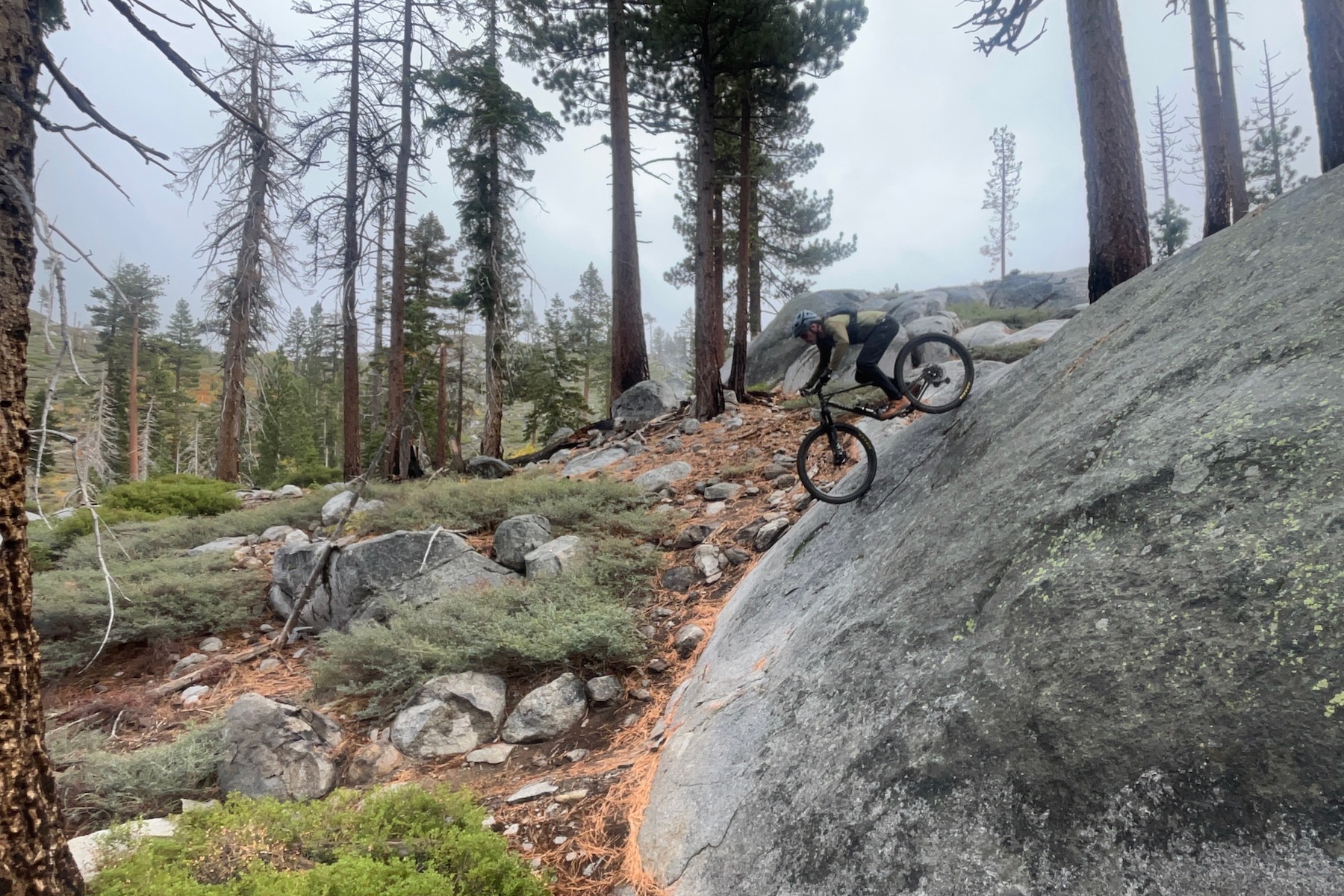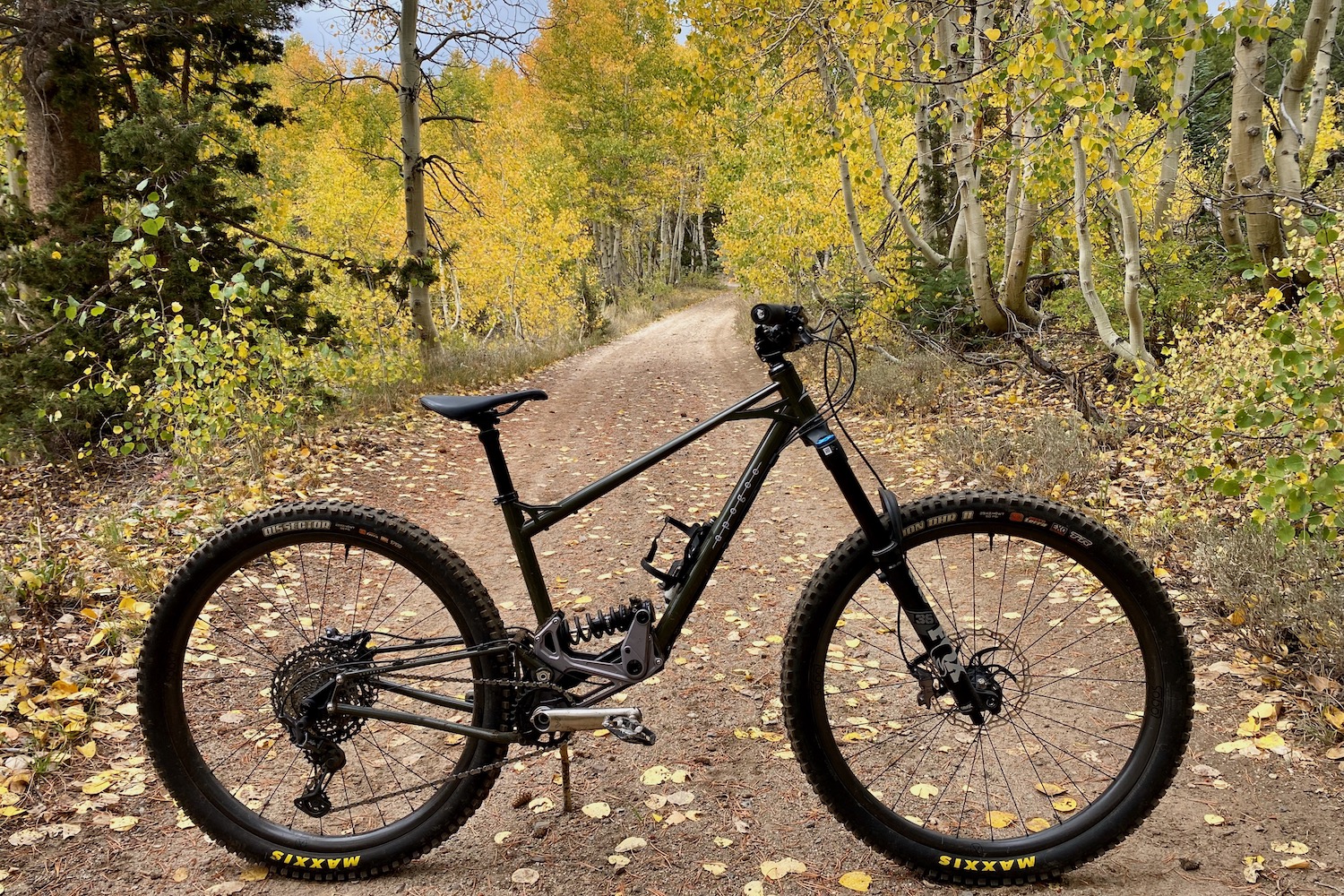The Apogee One is not your typical mountain bike. We first learned about this unquely designed full-suspension model a couple of years ago and caught our first glimpses of it at the 2023 MADE Show. It made it to production in the latter part of 2024, and just recently, I had the chance to meet up with one of the co-founders and take a little tour of the brand’s machine shop.
After checking out the Apogee Bikes machine shop a couple of weeks ago, co-founder Collin Huston set me up on his personal bike for a test ride. We headed out to one of my favorite loops in the South Lake Tahoe area for a cool, rainy, and delightfully colorful fall ride. Since one ride isn’t really enough to get a feel for a bike, Collin let me hang onto the Apogee One for a little longer, so I could make some adjustments and get some more miles on it.
I made some changes to suspension settings, handlebar controls, and touchpoints to dial it in to my preferences and squeezed in another couple of rides. In total, I logged around 60 miles of trail riding and ~7,500 feet of climbing and descending. That’s certainly not enough for a long-term review, but I got a really good feel for how it performs on a wide range of terrain, and what sets it apart from the mainstream competition.
First Things First

I’m gonna start this off by saying this bike looks freaking awesome. It really stands out from the crowd of similar-looking carbon and aluminum bikes with oversized tubes and familiar suspension designs. I don’t want to overstate it, but like many handmade bikes, it’s more like a functional piece of art than any mass-produced bike could ever hope to be.
The steel front and rear frame members bring some classic appeal, while the intricate, machined aluminum Free Float Module offsets that with a modern, sort of industrial look. Somehow, these seemingly opposing aesthetics blend together to make something that is incredibly unique-looking and eye-catching. Most people have never seen anything like it, and this bike gets lots of double-takes and questions.


In addition, the attention to detail and finish quality of both the steel frame and the machined Module components are quite impressive. The welds are super clean, and whoever is painting the frames appears to be doing an excellent job. The machine work on the Free-Float Module components appears to be very precise, creating a solid and stiff foundation for the suspension to perform at its best.
Speaking to the precision of the Free Float Module, I was also pleasantly surprised by how generally tight the whole bike felt, and how quiet it was. With that many bolts attaching the front and rear triangles to the Module, plus quite a few bearings, thru-bolts, and moving parts, there’s a lot of potential for noise. Wildly enough, I didn’t hear a peep. The external cable routing was also well executed and kept the cables tidy and rattle-free. Apogee also provides the option for internal routing if desired.
Geometry and Fit

I’m a little taller than Collin, but I decided to give his size M/L frame a shot. That was the only complete build he had on hand at the shop, and I didn’t feel the need to put him out by getting a large — with a 500 mm reach — sent down from one of his business partners. If I were purchasing one, I’d strongly consider bumping up to the large, but for a few test rides, I was happy to rip around on the M/L frame.
With a 470 mm reach, the M/L is a bit shorter than the 485 mm (ish) I’m used to, so we swapped out the 35 mm stem for a 50 mm to open it up a little bit. Still, with the properly steep 78-degree seat tube angle, the cockpit felt a touch compact for me while seated climbing, which wasn’t all that surprising. For reference, I’m 6’0” tall, and the top of the recommended user height range for the M/L is 5’11”. This somewhat compact feel didn’t bother me all that much, and I got along with the geometry quite well otherwise.
And beyond the reach, the Apogee is a fairly long bike. In fact, the M/L’s 1,253 mm wheelbase is 19 mm longer than my personal trail bike in a size large. The stack is also a bit higher, which pairs up pretty nicely with that 64-degree head tube angle. This bike is ready to get as aggressive as you want, yet it’s not so long and slack that it detracts from its maneuverability or versatility.
Climbing

Right off the bat, one of the first things I noticed was how calm the rear suspension was while grinding up a paved road. Both in the saddle and out, the amount of suspension movement was barely noticeable at all, which was even more remarkable given the coil shock. On the trail, it remained mostly calm under pedaling power, but opened up easily over bumps and rocky sections. Rear wheel traction was great throughout testing, and I had no issues clawing my way up numerous steep, scrappy, and loose climbs. I never touched the climb switch on the rear shock.
I also noticed the weight of the Apogee One right away. Collin’s complete build weighs around 36 pounds, which is ~6 pounds heavier than my everyday ride. In the context of a relatively aggressive trail bike, 36 pounds isn’t really all that heavy, but I’ll admit it was noticeable to me, comparatively speaking. While the bike felt plenty efficient, it just felt a tad sluggish compared to my lighter carbon ride, which is to be expected.
Realistically, nobody is buying a boutique steel full suspension bike because it’s lightweight, so take that for what you will. It still climbed well, handled easily and intuitively, and got me to the top of mountains so I could ride back down them. The main difference was that it felt like it sort of forced me into a mellower mindset, especially compared to lighter bikes that often feel like they’re urging me to push the pace.
Descending

Often, riding an unfamiliar bike downhill for the first time can take some getting used to. Body position, fore-aft balance, weight distribution, geometry, components, suspension settings, touch points, and more are all factors contributing to one’s comfort and control. I was pleasantly surprised to find the Apogee very easy to get along with, with virtually no getting-to-know-you period. I felt comfortable and confident from the first descent to the last. I’ll be quick to point out, however, that the Apogee’s geometry, travel, and weight make it best suited to the more aggressive side of the riding spectrum. This isn’t a snappy little whippet for racing around mellow trails at a Nordic Center. In my opinion, anyway.
There were a few factors at play here, but the geometry was one of the biggest, of course. The slack head tube angle and high stack put me in a commanding position, while the fairly long wheelbase let me settle in between the wheels. Staying centered on the bike kept both wheels weighted, and traction was easy to come by at both ends of the bike. On some properly steep rock rolls and skidders, I still needed to get the weight back a bit, but the slack front end and cushy suspension just ate that stuff up right up. I throttled this bike down some of my favorite chucky, high-speed, slappy, slabby descents, and it didn’t flinch.

The Free Float Module suspension design, paired with the Cane Creek Coil shock, was also working its magic. It took a little fiddling to get the compression and rebound settings exactly where I wanted them, but once I did, it was super plush and smooth. I found it really excelled in big single hits, staying composed and not wallowing deeper in the travel. The leverage rate is quite linear, but the coil gave it a nice progressive feel. Small bump performance was solid, and the mid-stroke support provided a platform to push, pump, and pop as desired.
And while the machined aluminum suspension linkage/Module is super stiff, the front and rear ends of the bike bring that chatter-muting, damp feel that steel is known for. Compared to so many super-stiff carbon and aluminum frames, the Apogee has a notably calm demeanor on the trail. It takes the edge off feedback, and the bike holds a line super well through rough, technical sections. And that is by design. The rear triangle has purposely been designed to have a little extra flex, and I found that noticeably reduced deflection and helped the bike track through chunky technical sections of trail. I think it also helped the rear wheel find and maintain grip in unlikely places like flat corners.
On the flip-side, I also noticed that the rear end could feel a tad vague when pushing hard into high-speed, hard-packed berms. I don’t know if I’d say that was a bad thing, per se, but it was noticeable and different than what I’m used to from riding stiffer frames all the time. It didn’t bother me necessarily, and I think I’d get used to it pretty quickly. That said, I could see the feel of the rear end potentially being somewhat polarizing, depending on your desired handling charateristics or terrain.
Apogee One: My Takeaway

When I think of handmade bikes, it’s usually steel or titanium hardtails or rigid gravel frames that come to mind. The added complexity of designing and executing rear suspension, along with the challenge of doing so with a frame material like steel, makes full-suspension bikes like the Apogee One far rarer than their non-squish siblings. But as we see every year at the MADE Show, they are increasing in number, and they just keep getting better (they look awesome anyway).
But what really sets the Apogee One apart is its one-of-a-kind suspension design — the machined aluminum Free Float Module — paired with a classic, hand-welded steel frame. It’s an unlikely marriage, but one that both makes sense and creates a very unique-looking ride. It’s unlike anything I’ve ever seen or thrown a leg over. And fortunately, beyond its retro/future looks, the Apogee also happens to be super fun to ride, especially on steeper, more aggressive trails with a bit of speed.
While it’s not the lightest bike or the zippiest climber, that’s not why anyone is buying a boutique bike like this anyway. This is a bike for riders seeking something completely different and unique, whether that’s its looks, design, or ride quality. The fact that it’s a blast to ride — in my opinion — definitely sweetens the deal.
